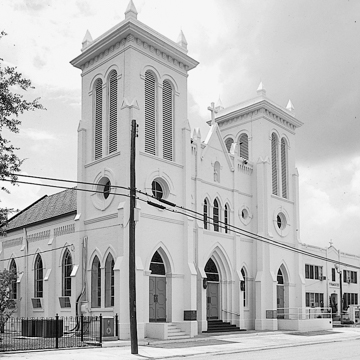This public space functions as a counterpart to the sporadically developed courthouse square and documents varied architectural styles and materials. At its western face, centered on Victoria Street, is St. Francis de Paula Catholic Church (1909) by Jules Leffland of Victoria. The sheer size of the Gothic Revival design provides a commanding presence over the plaza, which is landscaped with trees, benches, and a central bandstand. A one-part commercial block (c. 1905) at 202 St. Joseph Street with a cast-iron storefront was recently rehabilitated as a law office. The Levi Building at Mier Avenue and St. Peter's Street, with elaborate brick cornice and chamfered corner entrance, signals the arrival of Jewish mercantile families to San Diego, who came at the heyday of the sheep ranching economy. The north face of the plaza contains several caliche-block dwellings, including, at 211 St. Peter's Street, a large side-gabled residence (c. 1880) that represents the adaptation of a traditional South Texas building material to Anglo-American building types. In addition to this plaza and that of the courthouse, yet a third public space to the west, the Plaza de Alcalá, was reserved as an entertainment venue in the 200 block of Collins Avenue.
You are here
The Plaza
If SAH Archipedia has been useful to you, please consider supporting it.
SAH Archipedia tells the story of the United States through its buildings, landscapes, and cities. This freely available resource empowers the public with authoritative knowledge that deepens their understanding and appreciation of the built environment. But the Society of Architectural Historians, which created SAH Archipedia with University of Virginia Press, needs your support to maintain the high-caliber research, writing, photography, cartography, editing, design, and programming that make SAH Archipedia a trusted online resource available to all who value the history of place, heritage tourism, and learning.













